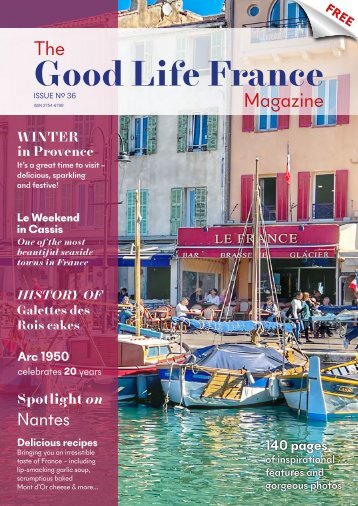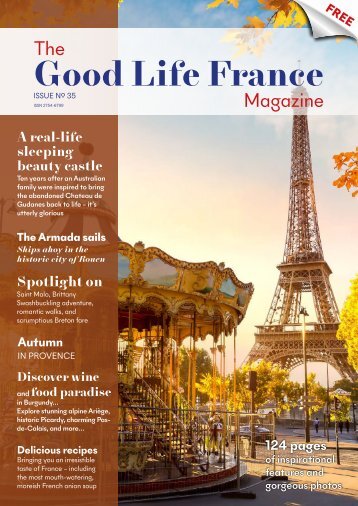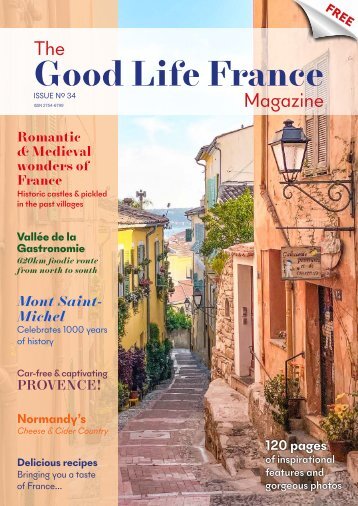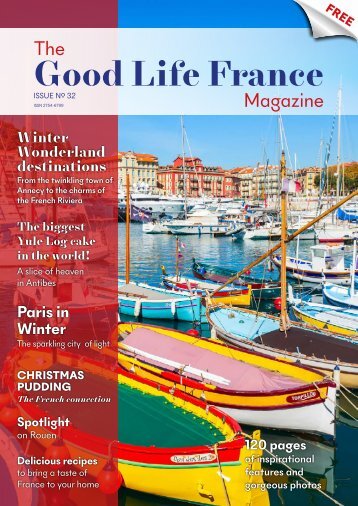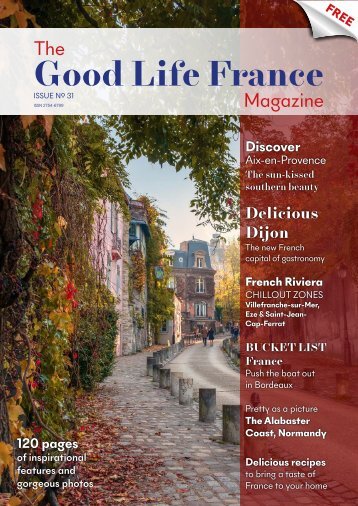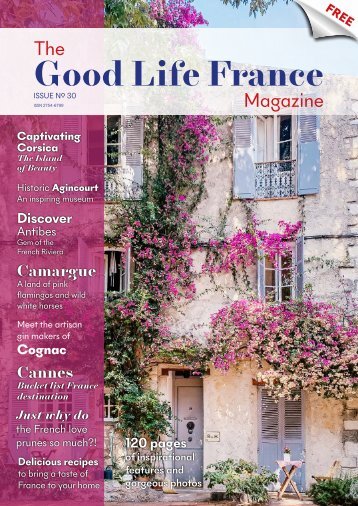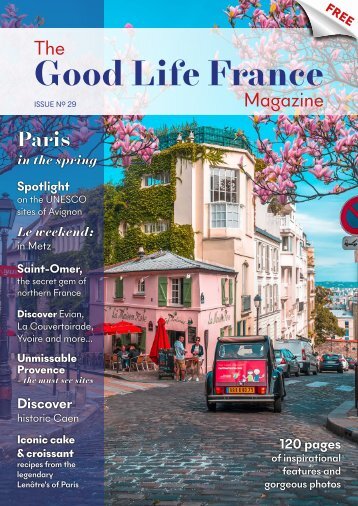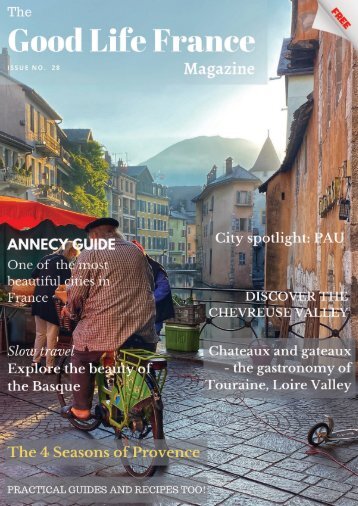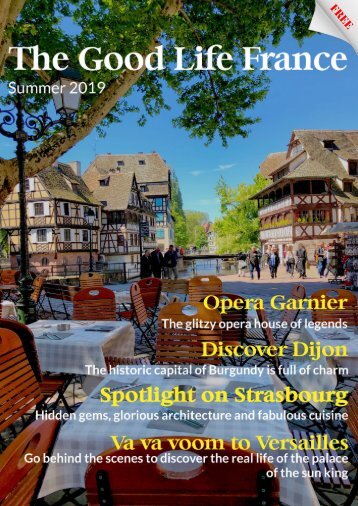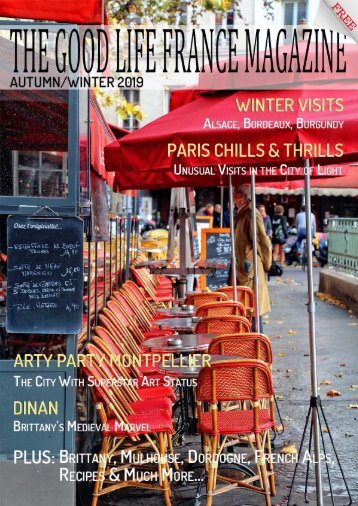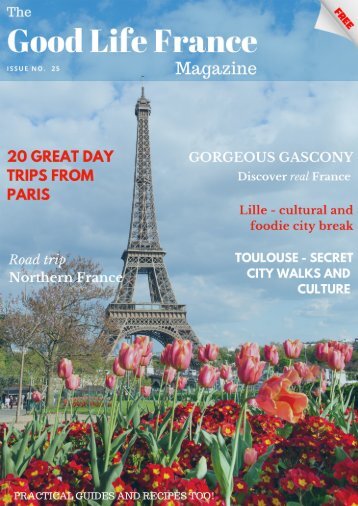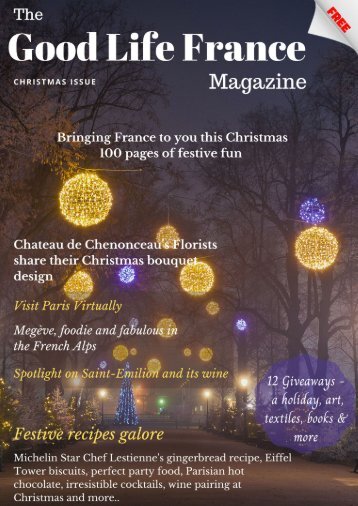
The Good Life France Magazine
The Good Life France Magazine brings you the best of France - inspirational and exclusive features, fabulous photos, mouth-watering recipes, tips, guides, ideas and much more...
Published by the award winning team at The Good Life France
Autumn 2022
Bird of Peace Alsace has
Bird of Peace Alsace has had a long association with its storks, known as störig in Alsatian, with a folktale dating back to 817. Louis the Pious, Emperor of the Carolingian Empire, wanted to divide his land among his three sons. Unfortunately, he was persuaded by his second wife to gift the full entitlement to her son only, which caused the other two sons to wage war against their father. The peaceful storks saw the devastation and bloodshed that followed. And with blood staining their beaks and feet as they surveyed the land, decided to dip the tip of their wings in black and lose their voice in mourning. Storks have remained silent ever since. Conservation of the white stork Mute from birth, storks communicate by body language and clapping their beaks. A fact that I learned at the NaturOparC, a stork sanctuary and wildlife education centre in the village of Hunawihr. In the 1970s, due to human expansion and loss of habitat, the stork population in Alsace hovered between extinction and survival until less than ten breeding pairs were sighted throughout the region. In 1983, a stork reintroduction programme was begun. One of the first repopulation centres was established in Cernay, whose 30 stork couples are often seen flying around the town centre along the river looking for food. Today, the region of Alsace is home to more than 600 couples. NaturOparC was part of this successful program, and continues to provide a safe, open sanctuary to storks that come to nest in the treetops. Other than the storks undergoing medical treatment, the birds are free to come and go as they please, and the fact that so many stay is a sign that the environment is ideal for them. Strategically built ladders and walkways allowed me to approach some of the nests at a safe distance (for the storks) and view them up close. Watching the storks relaxing in their nests, sleeping, preening, clapping their beaks – perhaps a couple in argument over whose turn it was to look after the baby – was a fairy tale moment, truly captivating. The wine bringers No visit to Alsace is complete without going to a few wine cellars for some tasting. And it is also of no surprise, that the storks have a beak in the wine business too. “Oh, there are plenty of storks this year,” chuckled the bartender at the Bléger winery in Saint-Hippolyte, a town famous for Alsace’s only red wine, Pinot Noir. “When there are plenty of storks in spring, you know we are going to have a good harvest in autumn.” Not only do the storks symbolise fertility, the Alsatian consider the storks to be the bringer of luck and wealth, and for the many winemakers of the region, they also bring a year of good harvest, meaning more wine for everyone. You can visit NaturOparC in Hunawihr as part of the Inntravel self-guided walking itinerary in Alsace. For more information visit: inntravel.co.uk 66 | The Good Life France The Good Life France | 67
- Page 1 and 2:
FREE The Good Life France ISSUE N
- Page 4:
To Subscribe to THE GOOD LIFE FRANC
- Page 8:
What to do and see in Aix You’d b
- Page 12:
eautiful shady garden. This is one
- Page 16: dip their sails in salute: “baiss
- Page 20: Painting by the sea Normandy’s Al
- Page 24: Monet 'at work' in Etretat Gardens
- Page 28: DIJON the new French capital of gas
- Page 32: 1204 which covers the history of Di
- Page 36: Nestled in a picturesque corner of
- Page 40: Le weekend in: OUISTREHAM Ouistreha
- Page 44: British NORMANDY MEMORIAL Gillian T
- Page 48: More flags fly on the grass between
- Page 52: of them decorated with scallop shel
- Page 56: Hospices de Beaune Wine bike © C L
- Page 60: Castles in the sky in the Dordogne
- Page 64: The STORKS of Alsace Amy McPherson
- Page 70: Château de Mont Cristo a hundred l
- Page 74: esort in the Belle Epoque era, the
- Page 78: Bay of angels Adam and Eve products
- Page 82: These personal effects were sealed
- Page 86: Tours de France Winter is one of th
- Page 90: Find out about French Insurance…
- Page 94: Prestige French Property & Lifestyl
- Page 98: Guide for US-Connected Persons Livi
- Page 102: Joanna Leggett explores the good li
- Page 106: The Port in Marseillan Marseillan a
- Page 110: Your one stop shop for the finest q
- Page 114: INGREDIENTS 1 cup/200gr All Purpose
- Page 118:
Last Word LOCAL KNOWLEDGE YOU CAN T
Inappropriate
Loading...
Mail this publication
Loading...
Embed
Loading...



